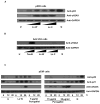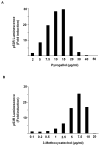Biological clues to potent DNA-damaging activities in food and flavoring
- PMID: 23402862
- PMCID: PMC3608747
- DOI: 10.1016/j.fct.2013.01.058
Biological clues to potent DNA-damaging activities in food and flavoring
Abstract
Population differences in age-related diseases and cancer could stem from differences in diet. To characterize DNA strand-breaking activities in selected foods/beverages, flavorings, and some of their constituent chemicals, we used p53R cells, a cellular assay sensitive to such breaks. Substances testing positive included reference chemicals: quinacrine (peak response, 51×) and etoposide (33×); flavonoids: EGCG (19×), curcumin (12×), apigenin (9×), and quercetin (7×); beverages: chamomile (11×), green (21×), and black tea (26×) and coffee (3-29×); and liquid smoke (4-28×). Damage occurred at dietary concentrations: etoposide near 5μg/ml produced responses similar to a 1:1000 dilution of liquid smoke, a 1:20 dilution of coffee, and a 1:5 dilution of tea. Pyrogallol-related chemicals and tannins are present in dietary sources and individually produced strong activity: pyrogallol (30×), 3-methoxycatechol (25×), gallic acid (21×), and 1,2,4-benzenetriol (21×). From structure-activity relationships, high activities depended on specific orientations of hydroxyls on the benzene ring. Responses accompanied cellular signals characteristic of DNA breaks such as H2AX phosphorylation. Breaks were also directly detected by comet assay. Cellular toxicological effects of foods and flavorings could guide epidemiologic and experimental studies of potential disease risks from DNA strand-breaking chemicals in diets.
Copyright © 2013 Elsevier Ltd. All rights reserved.
Figures




Similar articles
-
Salivary α-amylase, serum albumin, and myoglobin protect against DNA-damaging activities of ingested dietary agents in vitro.Food Chem Toxicol. 2014 Aug;70:114-9. doi: 10.1016/j.fct.2014.05.002. Epub 2014 May 16. Food Chem Toxicol. 2014. PMID: 24842839 Free PMC article.
-
Airway epithelial cell exposure to distinct e-cigarette liquid flavorings reveals toxicity thresholds and activation of CFTR by the chocolate flavoring 2,5-dimethypyrazine.Respir Res. 2016 May 17;17(1):57. doi: 10.1186/s12931-016-0369-9. Respir Res. 2016. PMID: 27184162 Free PMC article.
-
Genotoxic and apoptotic activities of the food flavourings myristicin and eugenol in AA8 and XRCC1 deficient EM9 cells.Food Chem Toxicol. 2011 Feb;49(2):385-92. doi: 10.1016/j.fct.2010.11.013. Epub 2010 Nov 16. Food Chem Toxicol. 2011. PMID: 21087650
-
Mechanisms of toxicity and biomarkers of flavoring and flavor enhancing chemicals in emerging tobacco and non-tobacco products.Toxicol Lett. 2018 May 15;288:143-155. doi: 10.1016/j.toxlet.2018.02.025. Epub 2018 Feb 23. Toxicol Lett. 2018. PMID: 29481849 Free PMC article. Review.
-
The safety evaluation of food flavoring substances: the role of genotoxicity studies.Crit Rev Toxicol. 2020 Jan;50(1):1-27. doi: 10.1080/10408444.2020.1712589. Epub 2020 Mar 12. Crit Rev Toxicol. 2020. PMID: 32162576 Review.
Cited by
-
Evaluation of blueberry juice in mouse azoxymethane-induced aberrant crypts and oxidative damage.Evid Based Complement Alternat Med. 2014;2014:379890. doi: 10.1155/2014/379890. Epub 2014 Sep 3. Evid Based Complement Alternat Med. 2014. PMID: 25258642 Free PMC article.
-
Tea intake and lung diseases: a Mendelian randomization study.Front Immunol. 2024 Feb 5;15:1328933. doi: 10.3389/fimmu.2024.1328933. eCollection 2024. Front Immunol. 2024. PMID: 38375474 Free PMC article.
-
Associations between tea and coffee beverage consumption and the risk of lung cancer in the Singaporean Chinese population.Eur J Nutr. 2020 Oct;59(7):3083-3091. doi: 10.1007/s00394-019-02146-7. Epub 2019 Dec 10. Eur J Nutr. 2020. PMID: 31822987
-
Salivary α-amylase, serum albumin, and myoglobin protect against DNA-damaging activities of ingested dietary agents in vitro.Food Chem Toxicol. 2014 Aug;70:114-9. doi: 10.1016/j.fct.2014.05.002. Epub 2014 May 16. Food Chem Toxicol. 2014. PMID: 24842839 Free PMC article.
-
Associations of coffee and tea consumption with lung cancer risk.Int J Cancer. 2021 May 15;148(10):2457-2470. doi: 10.1002/ijc.33445. Epub 2020 Dec 28. Int J Cancer. 2021. PMID: 33326609 Free PMC article.
References
-
- Bakke OM. O-methylation of simple phenols in the rat. Acta Pharmacol Toxicol (Copenh) 1970;28:28–38. - PubMed
-
- Berenbaum MC. A method for testing for synergy with any number of agents. J Infect Dis. 1978;137:122–130. - PubMed
-
- Birt DF, Hendrich S, Wang W. Dietary agents in cancer prevention: flavonoids and isoflavonoids. Pharmacol Ther. 2001;90:157–177. - PubMed
-
- Braun AG, Busby WF, Jr, Jackman J, Halpin PA, Thilly WG. Commercial hickory-smoke flavouring is a human lymphoblast mutagen but does not induce lung adenomas in newborn mice. Food Chem Toxicol. 1987;25:331–335. - PubMed
Publication types
MeSH terms
Substances
Grants and funding
LinkOut - more resources
Full Text Sources
Other Literature Sources

